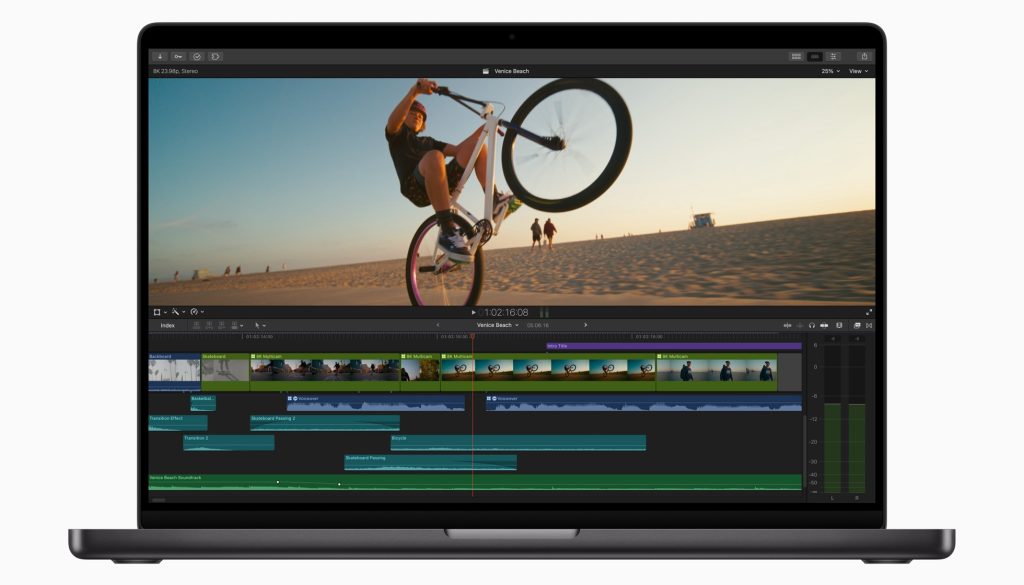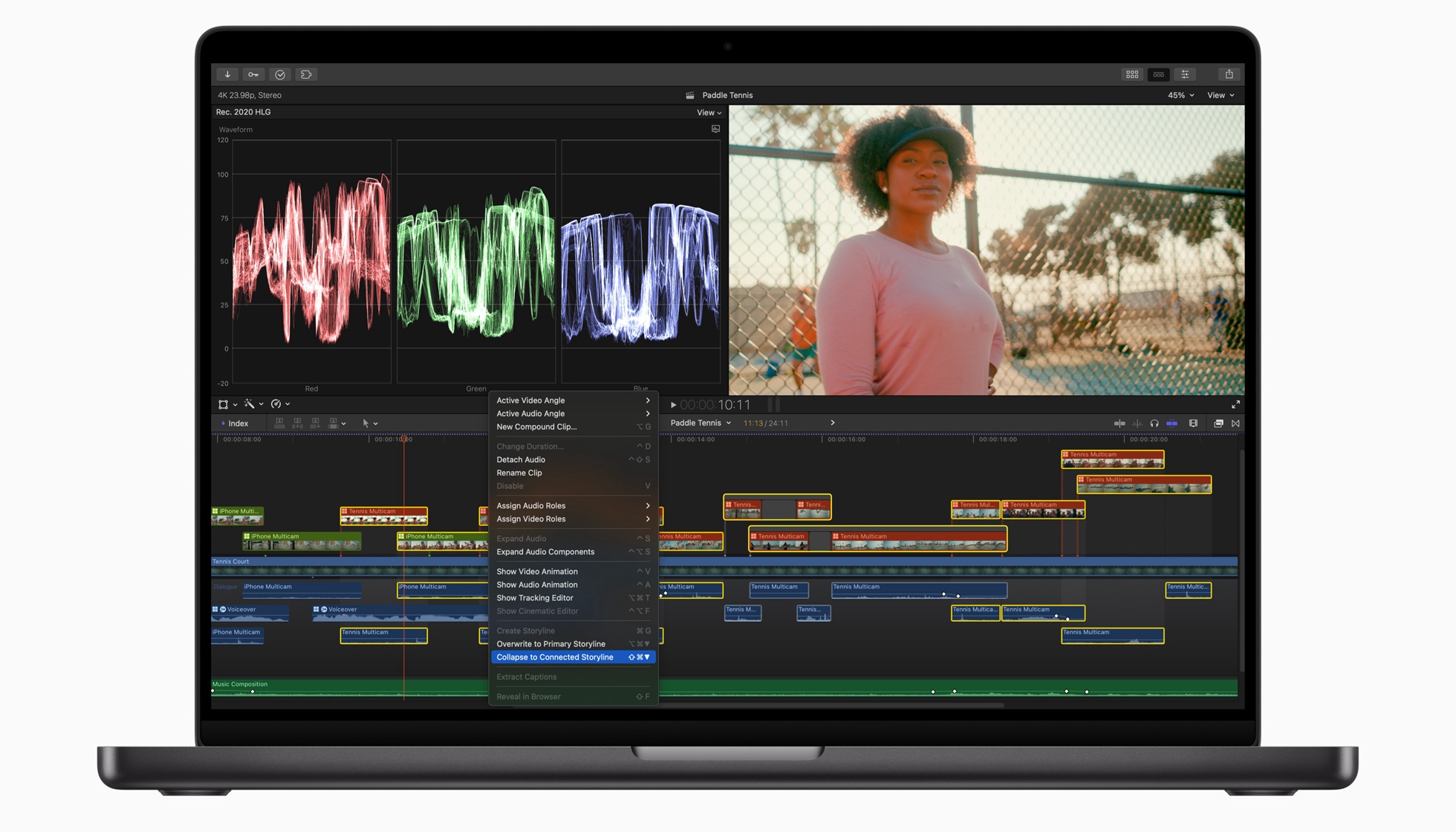A few weeks ago, I attended the Final Cut Pro Creative Summit – the first such event since 2019 – which included an invite to Apple Park. While visiting its campus, the next version of Final Cut Pro was revealed for the first time. Apple pre-announced its forthcoming update to Final Cut Pro for Mac, version 10.7, noting that it will be released later this month, presumably sometime this week if that timeline sticks.
The update includes one key feature that many Final Cut Pro enthusiasts have been wanting for well over a decade, along with several other enhancements that will help users stay organized and potentially speed up H.264 and HEVC exports. Personally speaking, I’m pumped to finally have these features, but as always, there will be a contingent that feels like Apple needs to do more…
Automatic Timeline Scrolling
Of all of the new features that Apple announced, automatic timeline scrolling is the one that I’m most excited about. Up until now, playing back footage in Final Cut Pro while zoomed in to the timeline would not automatically scroll to provide helpful context. If you scroll manually to find the playhead while the footage is playing back, you’ll notice that the remaining clips are blank and aren’t redrawn until playback is paused and started again.
Older versions of Final Cut Pro can use the excellent third-party plugin called CommandPost to enable timeline scrolling, but it’s not quite as nice as Apple’s official implementation.
At any rate, the lack of automatic timeline scrolling hasn’t prevented Final Cut Pro users from maintaining productivity, but it’s one of those quality improvements that will make it easier to maintain context during the editing process. Although I didn’t get to go hands-on with Final Cut Pro 10.7 during my time in Cupertino, we were provided with a demonstration of how it works, and it looks promising.
Not only does the timeline continue to scroll on playback, but it will make it so that all clips, including their corresponding waveforms, are properly redrawn in real-time as the playhead moves across the timeline.
Automatic timeline scrolling will thus also make it possible to adjust the timeline dynamically during playback. For example, you should be able to use zoom, and the clips will stay in view underneath the playhead during playback.

Of course, other NLEs have had timeline scrolling for years, but the implementation, at least in DaVinci Resolve, doesn’t seem to be quite as nice. The waveforms and clip previews in Resolve don’t maintain exact 1:1 accuracy when stopping playback, so you’ll see the clips jump a bit to settle in their actual place. Rest assured that I’ll be testing Final Cut Pro 10.7 to see how it stacks up against the others.
One of the questions that I’m anxious to find the answer to is how the new timeline rendering will handle voiceover recordings. As of now, when recording a voiceover in Final Cut Pro, the waveform remains blank until the voiceover is stopped. Given the way Apple explained it, I presume that waveforms for voiceovers will also be rendered on the fly, but I’m looking forward to personally confirming that.
Apple Silicon speed improvements
Apple Silicon has provided plenty of speed improvements over Intel machines, but with Final Cut Pro 10.7, editors will be able to tap further into the advantages of Apple’s M-series chips. If your Mac features more than one media engine – applicable to all “Max”, and “Ultra” Apple Silicon variants across M1, M2, and M3 — you will now be able to process H.264 and HEVC exports in parallel, with Final Cut Pro sending video segments to all available media engines for simultaneous processing.
Additionally, the object tracker features a new machine learning module that provides faster and more accurate analysis of objects and faces when using Macs with Apple Silicon.
Connected Storylines
For longer, more complex videos — think my annual iOS walkthroughs — the Final Cut Pro timeline can quickly become unwieldy. That’s why I was happy to see Apple reveal a new ability to create connected storylines out of a group of overlapping connected clips.

In Final Cut Pro 10.7, simply select a group of overlapping connected clips, right-click, and select Collapse to Connected Storyline. The connected clips will then be collapsed into a much cleaner connected storyline that can quickly be expanded in place on demand without moving the user to a secondary timeline like compound clips do. Final Cut Pro 10.7 lets users combine connected clips with existing connected storylines to further streamline the timeline.
Improved Roles

Roles have also received improvement in the forthcoming Final Cut Pro update. New enhancements let users easily differentiate clips via their assigned roles and will allow editors to highlight clips by their roles using customizable colors.
9to5Mac’s Take
Final Cut Pro 10.7 is shaping up to be a solid update and includes long-awaited features like automatic timeline scrolling. Having the ability to tap into multiple media engines on export is also a noteworthy enhancement, as is the ability to create instantly expandable and collapsible connected storylines.
Yet, there are still quite a few glaring omissions that Final Cut Pro users have been pining for, and those thinking we might get them with this update may come away a bit disappointed. For example, text-based editing, a feature on competing NLEs from Blackmagic Design and Adobe, would allow users to edit their footage based solely on rearranging speech-to-text dialogue. This, along with integrated audio transcription, seems like an obvious feature given the power of the Neural Engine in Apple’s M-series chips.
I’d also like to see Logic Pro integration for enhanced audio mixing and editing, more customizable modular workspaces akin to what users have in Premiere Pro, and integrated collaboration tools.
So yes, there will always be a contingent of users who will be disappointed with every Final Cut Pro update due to the lack of a much-wanted feature. Given Apple’s organizational and management structure, we’ll probably never see the type of constant updates that we get from companies like Blackmagic Design, or even Adobe to a lesser extent.
Would I like more features at increased intervals? Of course. Was I sad to see that text-based editing didn’t make the cut? Indeed. But at the same time, the features that were revealed, namely the scrolling timeline, and exports making better use of the media engines in Apple Silicon, made me extremely happy. In some light, the more measured release strategy could be viewed as a strength, because Final Cut Pro has provided me with a much stabler product when compared to other NLEs. I’m not saying that to make excuses for Apple, but that’s largely been my experience.
However you choose to view it, what is clear is that the Pro Apps team takes Final Cut Pro seriously, and it continues to be a priority. Apple is a company that is infamously guarded with details of unreleased products, yet it felt it was important enough to invite a group of Final Cut Pro enthusiasts to its campus to reveal its newest version for both Mac and iPad before anyone else had seen it. If that doesn’t speak to its commitment, I don’t know what does.
Final Cut Pro 10.7 for Mac and 1.3 for iPad will be available by the end of the month, which means it could be anytime this week. We’ll, of course, be back with hands-on coverage post-release. be sure to Subscribe to 9to5Mac on YouTube for more.
FTC: We use income earning auto affiliate links. More.










Comments